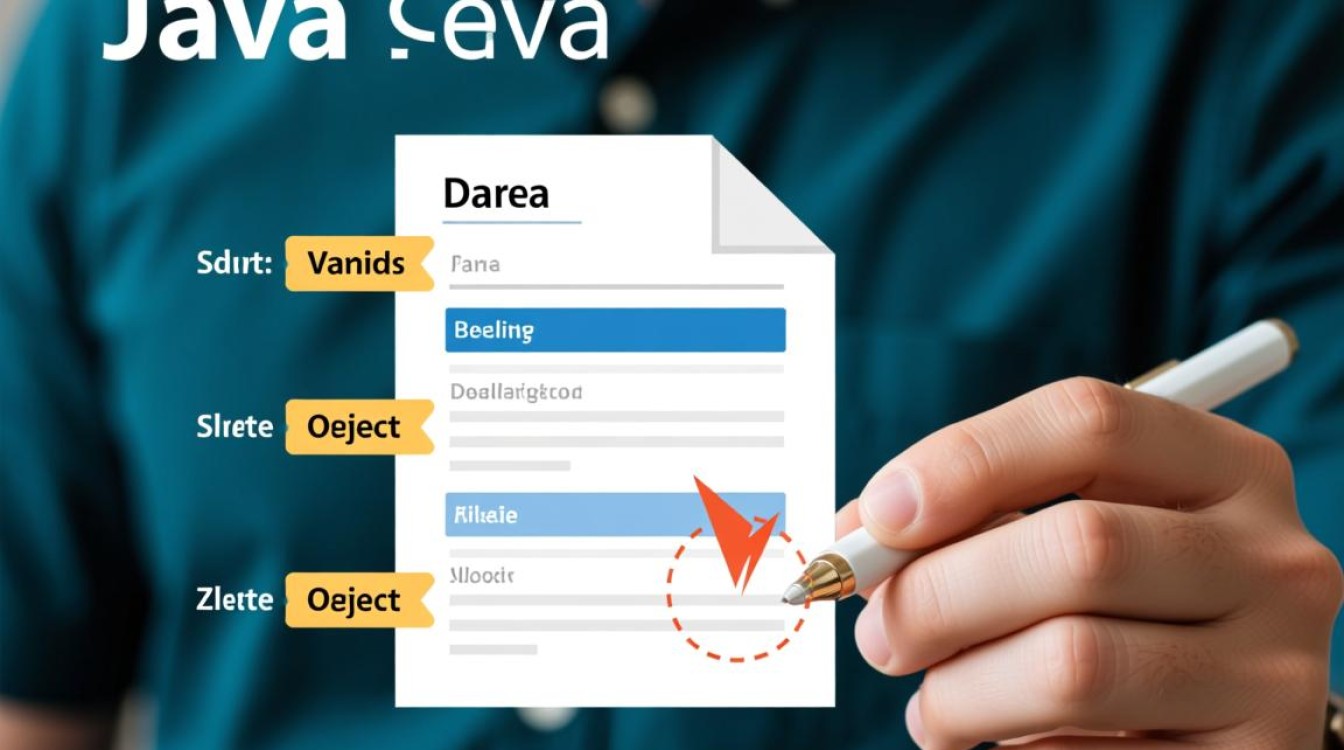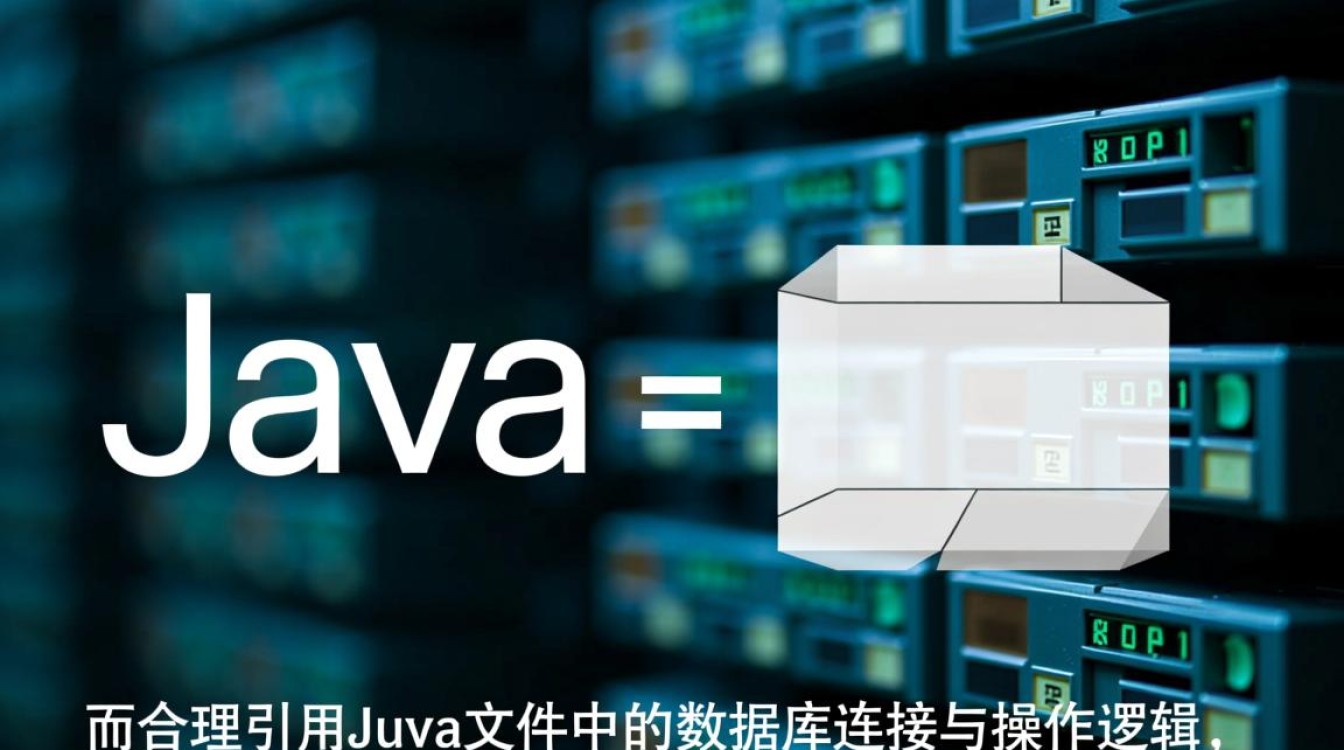在Java开发中,引用Java文件里的数据是基础且核心的操作,涉及变量、对象、集合、文件读取等多种方式,掌握这些方法不仅能提升代码效率,还能确保数据处理的准确性和安全性,以下从不同场景出发,详细解析如何引用Java文件中的数据。

基本数据类型与变量的直接引用
Java中最简单的数据引用方式是通过变量直接访问,在类中定义基本数据类型(如int、double、char)或引用类型(如String)的变量后,可通过变量名直接获取其值。
public class DataExample {
private int number = 10;
private String text = "Hello, Java!";
public void displayData() {
System.out.println(number); // 直接引用变量number
System.out.println(text); // 直接引用变量text
}
}
这种方式适用于数据量小、生命周期与类或方法绑定的场景,但需注意变量的作用域(局部变量、成员变量、静态变量)对访问范围的影响。
通过对象引用复杂数据结构
当数据需要封装多个属性时,可通过创建对象来引用,定义一个Student类,通过实例化对象并调用其方法或属性获取数据:
public class Student {
private String name;
private int age;
public Student(String name, int age) {
this.name = name;
this.age = age;
}
public String getName() { return name; } // 通过getter方法引用属性
}
public class Main {
public static void main(String[] args) {
Student student = new Student("张三", 20);
System.out.println(student.getName()); // 通过对象引用name属性
}
}
对象引用适用于面向对象编程场景,可通过封装、继承等特性管理复杂数据,同时需注意空指针异常(NullPointerException),建议使用Objects.requireNonNull()进行校验。
集合框架的批量数据引用
Java集合框架(如List、Set、Map)提供了高效的数据存储与引用方式,通过ArrayList存储一组数据后,可通过索引或迭代器访问:
import java.util.ArrayList;
import java.util.List;
public class CollectionExample {
public static void main(String[] args) {
List<String> fruits = new ArrayList<>();
fruits.add("Apple");
fruits.add("Banana");
// 通过索引引用
System.out.println(fruits.get(0)); // 输出: Apple
// 通过for循环遍历引用
for (String fruit : fruits) {
System.out.println(fruit);
}
}
}
对于键值对数据,HashMap是常用选择:
import java.util.HashMap;
import java.util.Map;
public class MapExample {
public static void main(String[] args) {
Map<String, Integer> scores = new HashMap<>();
scores.put("Math", 90);
scores.put("English", 85);
System.out.println(scores.get("Math")); // 通过key引用value
}
}
集合引用时需注意线程安全(如Collections.synchronizedList)和泛型类型匹配,避免ClassCastException。

从文件中读取数据引用
当数据存储在外部文件(如.txt、.csv、.json)中时,需通过IO流读取并引用,以读取文本文件为例:
import java.io.BufferedReader;
import java.io.FileReader;
import java.io.IOException;
public class FileReadExample {
public static void main(String[] args) {
String filePath = "data.txt";
try (BufferedReader reader = new BufferedReader(new FileReader(filePath))) {
String line;
while ((line = reader.readLine()) != null) {
System.out.println(line); // 逐行引用文件数据
}
} catch (IOException e) {
e.printStackTrace();
}
}
}
对于结构化文件(如JSON),可使用第三方库(如Gson、Jackson)解析为对象后引用:
import com.google.gson.Gson;
public class JsonExample {
public static void main(String[] args) {
String jsonStr = "{\"name\":\"李四\",\"age\":25}";
Gson gson = new Gson();
Person person = gson.fromJson(jsonStr, Person.class); // 解析为对象引用
System.out.println(person.getName());
}
}
文件操作时需注意异常处理(try-with-resources自动关闭资源)和文件路径的正确性。
数据库数据的引用
企业级应用中,数据通常存储在数据库中,通过JDBC(Java Database Connectivity)引用:
import java.sql.*;
public class DatabaseExample {
public static void main(String[] args) {
String url = "jdbc:mysql://localhost:3306/test";
String user = "root";
String password = "password";
try (Connection conn = DriverManager.getConnection(url, user, password);
Statement stmt = conn.createStatement();
ResultSet rs = stmt.executeQuery("SELECT * FROM users")) {
while (rs.next()) {
String name = rs.getString("name"); // 通过列名引用数据
int age = rs.getInt("age");
System.out.println(name + ": " + age);
}
} catch (SQLException e) {
e.printStackTrace();
}
}
}
数据库引用需注意连接管理(使用连接池如HikariCP)、SQL注入防护(使用PreparedStatement)和结果集的及时关闭。
配置文件数据的引用
Java应用常通过配置文件(如.properties、.xml)管理参数,可通过java.util.Properties读取:
import java.io.FileInputStream;
import java.io.IOException;
import java.util.Properties;
public class ConfigExample {
public static void main(String[] args) {
Properties props = new Properties();
try (FileInputStream fis = new FileInputStream("config.properties")) {
props.load(fis);
String dbUrl = props.getProperty("db.url"); // 通过key引用配置值
System.out.println(dbUrl);
} catch (IOException e) {
e.printStackTrace();
}
}
}
Spring框架中,可通过@Value注解直接注入配置值:

import org.springframework.beans.factory.annotation.Value;
import org.springframework.stereotype.Component;
@Component
public class AppConfig {
@Value("${app.name}")
private String appName; // 注入配置文件中的app.name
public void printName() {
System.out.println(appName);
}
}
配置文件引用需注意路径解析和默认值设置(如props.getProperty("key", "default"))。
网络数据的引用
通过HTTP请求获取远程数据(如调用RESTful API),可使用HttpURLConnection或第三方库(如OkHttp、Apache HttpClient):
import java.io.BufferedReader;
import java.io.InputStreamReader;
import java.net.HttpURLConnection;
import java.net.URL;
public class NetworkExample {
public static void main(String[] args) throws Exception {
String apiUrl = "https://api.example.com/data";
URL url = new URL(apiUrl);
HttpURLConnection conn = (HttpURLConnection) url.openConnection();
conn.setRequestMethod("GET");
try (BufferedReader reader = new BufferedReader(new InputStreamReader(conn.getInputStream()))) {
String line;
StringBuilder response = new StringBuilder();
while ((line = reader.readLine()) != null) {
response.append(line);
}
System.out.println(response.toString()); // 引用网络响应数据
}
}
}
网络请求需注意异常处理、超时设置和线程安全(避免在主线程中执行耗时操作)。
引用Java文件中的数据需根据数据类型、存储位置和业务场景选择合适的方式,从简单的变量引用到复杂的数据库操作,核心在于理解数据的生命周期、作用域及访问控制,需注重异常处理、资源释放和安全性,确保数据引用的稳定与可靠,通过灵活运用上述方法,可有效提升Java程序的数据处理能力。


















